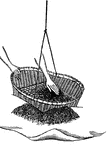
Leopard Plant
Leopard plant is the common name of ligularia kaempferi aureo-maculatus. The leaves are blotched with…
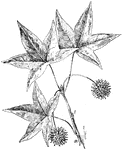
Sweet Gum
Sweet gum and bilsted alligator tree are the common names of liquidambar styraciflua. The leaves are…

Tomato Leaves
Illustrated are leaves of tomatoes. (1) lycopersicum esculentum grandiflorum, (2) vulgare variety, and…

Tree Tomato
Tree tomato or upright tomato is the common name of lycopersicum esculentum validum. It looks like a…

Lycoris Squamigera
The flowers of lycoris squamigera are rosy lilac and banded yellow. The bulb is round. THe leaves are…
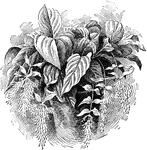
Medinilla Magnifica
Medinilla magnifica is an evergreen shrub native to the Philippines. Its leaves have nine to thirteen…

China Tree Leaf
Illustrated is a leaf of melia azedarach. The common names are China tree, China berry, and pride of…
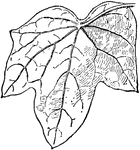
Moonseed Leaf
Illustrated is the leaf of the common moonseed, menispermum canadense. The leaves vary in shape. Some…
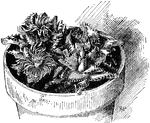
Mesembryanthemum Felinum
The flowers of mesembryanthemum felinum are yellow. The leaves are two inches or less in length and…
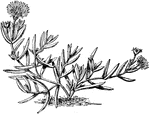
Mesembryanthemum Aureum
The flowers of mesembryanthemum aureum are golden and two inches across. The leaves are about two inches…
Miconia Magnifica
Miconia magnifica is native to Mexico. The leaves are very large, growing over two feet long.

Four O' Clock
Four o' clock and "Marvel of Peru" are the common names of mirabilis jalapa. The flowers grow in clusters…

Oswego Tea
Oswego tea, bee balm, and fragrant balm are the common names of monarda didyma. The stems are angled.…
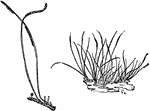
Monogramma Trichoidea
Monogramma is a grass-like fern. The trichoidea variety is a tiny, bark inhabiting plant with thread…
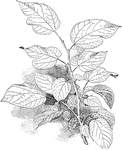
White Mulberry
White mulberry is the common name of morus alba. The leaves are light green, small, and smooth. The…
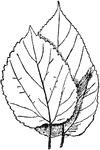
Mulberry Leaf
Illustrated are the leaves of morus alba (b) and morus multicaulis (a). Both are varieties of mulberry.
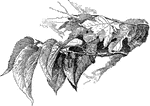
Native Red Mulberry
The leaves of the native red mulberry are very large. The fruit is deep red or almost black when fully…

Myrtle
Myrtle is the common name of myrtus communis. It is an evergreen shrub that grows three to ten feet…
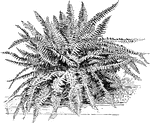
Nephrolepis Bostoniensis
Nephrolepis bostoniensis is a free growing fern with dark green, spreading leaves. It is good as a pot…
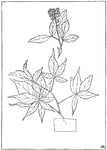
Nephrolepis Elegantissima Compacta
The leaves of nephrolepis elegantissima compacta are about a foot long, erect, dense, and numerous.

Nephrolepis Magnifica
Nephrolepis magnifica is a free grower of open habit. The leaves are erect and fifteen inches long.

Nephrolepis Muscosa
The leaves of nephrolepis muscosa are six to eight inches long and four to five inches broad. The leaves…

Nerine Mansellii
Nerine mansellii is a hybrid. It has very broad fleshy leaves. The flowers are bright red and slightly…
Beaucarnea Guatemalensis
Beucarnea guatemalensis is native to Guatemala. The tree grows twenty feet tall. The leaves are green,…
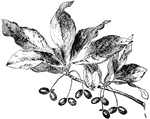
Nyssa Sylvatica
Nyssa sylvatica has several common names including tupelo, pepperidge, black gum, and sour gum. The…
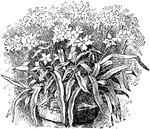
Odontoglossum Crispum Habit
The flowers of odontoglossum crispum bloom in crowded clusters. The leaves are a foot long. The plant…
Wandering Jew
A cutting of a wandering Jew plant in a glass of water. Wandering Jews are common houseplants with multicolored,…

Respiration Diagram
A diagram of how respiration works. A balloon is attached to the end of a small oil lamp chimney. The…

Heart Cycle
The cycle of the heart in its diastole (relaxation) state and its systole (contraction) state. The ventricles…

Three tea leaves
Three Chinese tea leaves. In some Chinese tea making processes, only the first three leaves were picked.

Plucked Tea Leaves (Six)
Unlike Chinese tea making methods (which involve plucking only three leaves), Indian methods are shown…

Drying Tea Leaves
Tea leaves are placed in the basket atop the oven and receive a steam bath, drying them out.

Leaves in Furnace
Five pounds of tea leaves are taken out of the steam bath and put in a stone furnace.

Gridiron support (Tea Making)
A wooden tray designed to encase a gridiron support, which in turn holds tea leaves heated in the furnace.

Sorting Leaves
The tea leaves are taken to long, low tables where the stems and uncurled leaves are separated and discarded.
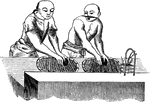
Tea Balls
The tea leaves are steamed until they reach a desirable fragrance. They are then rolled or kneaded by…
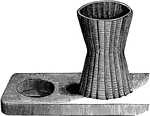
Cylindrical Basket
The tea sieves are placed in a cylindrical basket that is slightly contracted in the middle.

Drying and Rolling Tablet
Tea leaves can be dried in sunlight and rolled by means of a channeled stone tablet with hollow sides…

Tea Drying in Baskets
Tea leaves are placed in tiered, horizontally arranged baskets. The floor has a channel running its…
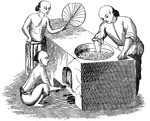
Tea Leaf Treatment
A kuo basket is placed above a furnace to be hand-stirred by a worker in order to regulate the leaf…
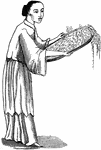
Winnowing Tea Leaves
Tea leaves are passed through sieves then winnowed via tossing on large bamboo trays.
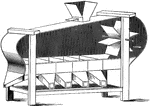
Winnowing Machine
A winnowing machine was traditionally used to separate yield from chaff. The pictured type of winnowing…

New Zealand Flax (Flowers)
New Zealand Flax is a liliaceous plant bearing tough, radical leaves, usually about four feet in length.…

New Zealand Flax (Fruit)
New Zealand Flax is a liliaceous plant bearing tough, radical leaves, usually about four feet in length.…

Flowering Rush
A European plant which grows in stagnant or nearly stagnant water. It has long, sword-shaped leaves,…

Galeopithecus
Galeopithecus is the generic name of certain mammals from the Malayan region, commonly (incorrectly)…

Geum Urbanum
Geum urbanum is a member of the genus Geum, a genus of hardy plants (Rosaceae). Not usually used decoratively,…

Glaux Maritima
Also known as Sea Milkwort, Glaux Maritima is a hardy perennial seashore plant belonging to the order…

British Golden-rod
British Golden-rod is a member of the large composite genus Solidago, which is chiefly North American.…
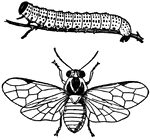
Gooseberry Caterpillar (Nematus ribesii) and Sawfly
Gooseberry Caterpillar is the name applied to the larvæ of two different insects, both injurious to…

Ground Ivy
Ground Ivy (Glecoma hederacea) is a common European labiate hedgerow plant, with trailing stems, kidney-shaped,…

Guelder Rose
Also known as the Snowball Tree, the Guelder Rose is a cultivated form of the genus Viburnum, especially…

Langur
A langur is a monkey of the genus Semnopithicus, which contains Asiatic forms characterized by slender…




